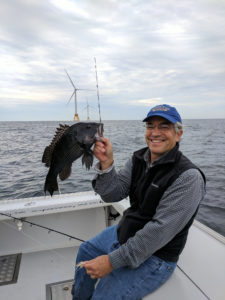There are many reasons to support responsibly developed offshore wind power. It is a clean energy source that is good for wildlife; it is affordable, reliable and available right near areas of concentrated energy demand like New York City and Boston; and, it can create tens of thousands of good-paying jobs. But, there is one benefit that advocates are just starting to recognize – the foundations that offshore wind turbine stand on are creating hotbeds for recreational saltwater anglers.
The nearly 4,000 offshore wind turbines operating worldwide (only five of which are in the U.S.) offer ample evidence. Numerous studies from Europe, where the offshore wind industry has been booming for years, have demonstrated that the pilings that support the turbines attract a variety of benthic organisms – that is worms, clams, crabs, lobsters sponges and other small organisms.

Environmental League of Massachusetts Board Member Pete Pedersen with a black pass. Photo: NWF
This smorgasbord of prey attracts larger fish species up the food chain.
In the case of Block Island, Rhode Island, the site of America’s first and only offshore wind turbines, a recent trip of National Wildlife Federation board members, partners and representatives from our state-based affiliates across the Northeast found the turbines attracted likely thousands of black bass, and a handful of scup. Within minutes of reaching the turbines, our crew was into fish. At one point, fishing with three rods with two baited hooks a piece, we had a total of five black bass hooked – and this kind of action continued all morning until our arms were tired. Rich Hittinger, a Vice President for the Rhode Island Saltwater Anglers Association and our host for the day, said he had also caught or heard reports of summer flounder, tautog and cod in the area throughout the summer.
Deepwater Wind, the developer of the Block Island turbines, worked with local anglers to identify potential conflicts. Local captains were invited to England to hear from fishermen how their wind farms had improved or changed their fishing. Continuing to listen to local anglers will be incredibly important as we develop this resource. Block Island is home to five turbines totaling 30 megawatts in power.. With commitments from states like Massachusetts, New York, New Jersey, and Maryland to develop thousands of megawatts of offshore wind power, there is a significant opportunity to create more fish habitat, but it must be done responsibly.
Deepwater Wind assured the local anglers they would be able to fish right up to the pilings as long as fishing boats were not anchored or moored to the turbine structure. We tested this theory, finding ourselves so close to the pilings we could have bounced lures off them. Later in the morning, a workboat joined us at the base of one turbine as its crew hoisted goods to the turbine platform.

Fishing is permitted right up to the base of the turbines, even while crews are working. Photo: NWF
There is still much to learn and to consider as we advocate for the responsible development of this resource. Are turbines bringing together fish, or actually contributing to population growth? Where should turbines be sited to minimize conflict with recreational anglers? How can we ensure anglers have access to these essentially giant artificial reefs?
“Many anglers, including me, fished the Block Island wind farm this year with very good results. Summer flounder (fluke) and black sea bass fishing in the wind farm area in the summer was arguably the best it has been in a long time.”
-Captain Dave Monti, On The Water
The National Wildlife Federation is eager to work with anglers and partner organizations to answer these questions, but at least here in Block Island, it seems to be making the fishing better. That’s great news, because recreational anglers are also confronting the challenges of fossil fuel pollution that can be addressed by developing clean energy like offshore wind power. Not only is warming water from climate change bringing species like summer flounder and black bass farther north than they’ve been before, but even mercury pollution from coal-fired power plants has led to restrictions on the amount of species like striped bass that individuals should eat. Recreational anglers have much to gain from offshore wind on all fronts – and we want your help.
If you want to join this effort – email me at CockrumZ@nwf.org to learn more.
Source: offshore wind
 Offshore Wind Energy
Offshore Wind Energy 

